At the beginning of the season, I thought goaltending was going to be the biggest issue for the Nashville Predators. Many fans were left questioning if Pekka Rinne was too old and over the hill or if Juuse Saros was ready to take over the mantle and become a true starting goaltender. Nevertheless, we all waited patiently for the season to begin and for our questions to be answered.
The season came and as games went by, one thing became apparent. Goaltending is far from the issue with the Nashville Predators, and, if anything, it’s been the only consistent this season. The worst part is that the goalies are rarely receiving any help, whether it’s from the offense or defense. Let’s take a deep dive into how little assistance Rinne is getting on both ends of the ice, and whether or not the wins can keep coming in these situations.
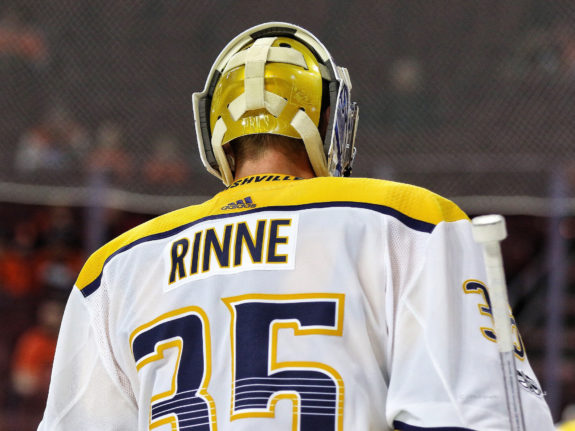
The Defensive Zone
The Nashville Predators boast the most talented defense in the NHL, and, while it’s close, no other top four compares. P.K. Subban is a Norris-level talent who probably deserves it again this season. Mattias Ekholm has grown into a dominant shot suppression artist who can turn star players into a non-factors. Roman Josi is the newest captain of the Predators and generates the most shots per 60 minutes of any player on the team. He’s an offensive dynamo who acts more like a rover than a defenseman at times. Then there’s the bearded hero, Ryan Ellis. Ellis is an undersized, yet physically dominating defenseman who is great on both sides of the puck.
Despite this generational top four, take a look at the horrorshow that is the Predators’ defensive zone season heat map.
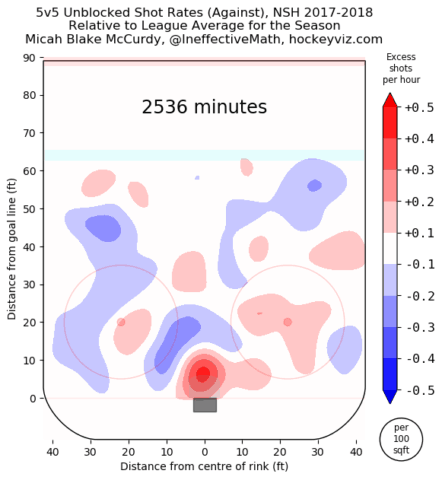
To get things started, blue means good while red means bad. There’s quite a bit of blue in this picture, especially around the point. That’s definitely a good thing, but the point is generally a low danger area. The area I care most about is the slot and net front. Those are the high-danger areas and this image presents mixed results.
The slot is mostly blue which means that centers are doing a great job of shutting off access, that’s most likely due to great two-way play from Ryan Johansen, Nick Bonino, and Calle Jarnkrok. Then there’s the net front, which is by far the worst area for the Predators. Not only is it the worst, but it’s also the most important area on defense. Rinne is facing an unprecedented amount of chances from the net front, and he’s been absolutely stunning.
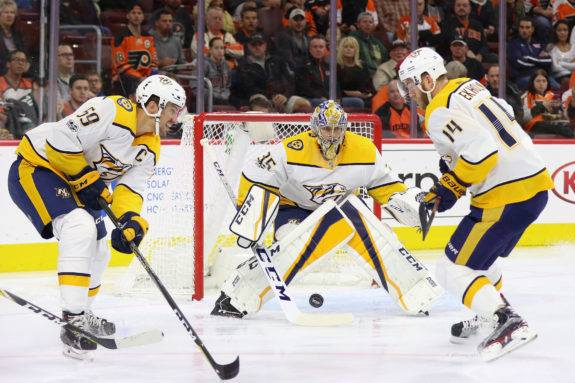
At five-on-five, Rinne has only allowed 32 high danger goals on 322 high danger chances! That comes out to be about a 91% save percentage if we’re rounding slightly up. That’s beyond impressive as goalies tend to only save around 78% of shots from that area over the course of a season. Rinne has actually given up the fourth-fewest high danger goals of all the starting goaltenders in the NHL, without much help from his defense.
If this defensive zone coverage keeps up, it’s going to be a very short playoff run, as teams will get much better offensively. Hot goaltenders cover a lot of mistakes, but as the Predators found out last postseason, goaltending magic runs out.
The Offensive Zone
You might be asking, “how does the offense affect the Predators goaltending?” Well, Pekka Rinne or Juuse Saros might grip their stick a little looser if they didn’t know that their offense was only going to put up one or two goals at five on five each and every night. With that said, let’s go to the heat map.
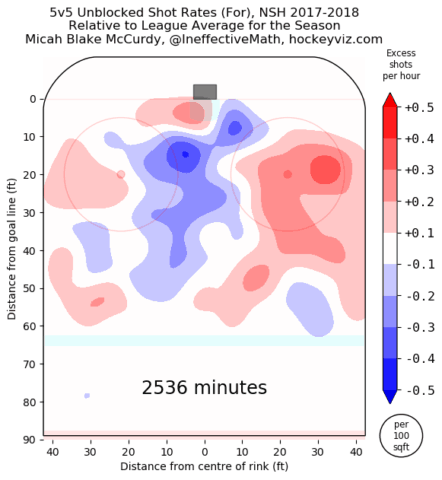
This would be a perfect map… if it was the Predators’ defensive zone. But since it’s the Predators’ offensive zone, it’s not a good omen for the future. Nashville is one of the worst teams in the NHL at putting up high danger chances, as they’re 26th in the NHL. A goaltender needs to be able to trust his offense, but his offense has let him down on multiple occasions.
The Predators routinely like to work the perimeter in hopes of opening up the slot, which is a fine and trusted strategy, except that the Predators never make their way into the slot. Their skill has covered up a lot of mistakes, but a team who boasts Filip Forsberg, Ryan Johansen, Kyle Turris, and Kevin Fiala should not be 18th in the NHL at five on five scoring. They should be top 10 at least, but alas, they’re not.
The Issue At Hand
This is probably the second-best roster in the NHL, and while it does have holes, so does every other team. Even Tampa Bay is looking around for a rental, and they might be the most dominant roster I’ve seen this decade. The issue here is not the players, but the strategy. I’m not going to say that Peter Laviolette and his group of merry coaches are solely failing Pekka Rinne, but they’re the main reason the Predators are having to rely so heavily on Vezina quality goaltending.
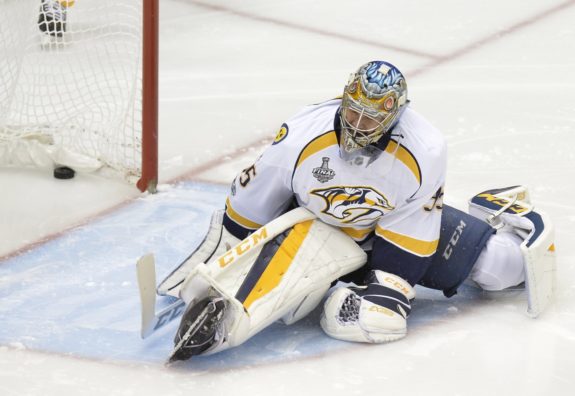
Pekka Rinne is having a stellar season and it’s a shame that his teammates in front of him are relying on him so heavily. This isn’t a system that will take the Predators far into the playoffs, and it would be a shame to reward Rinne’s incredible play with this terrible effort in front of him. Hot goaltending can go cold at a moment’s notice, and the Predators will need to step up if when it happens.
Unless something changes soon, I fear the Nashville Predators will continue to disappoint Rinne. The coaching staff needs to take a hard look in the mirror and think of a way to correct the problems that face this franchise.